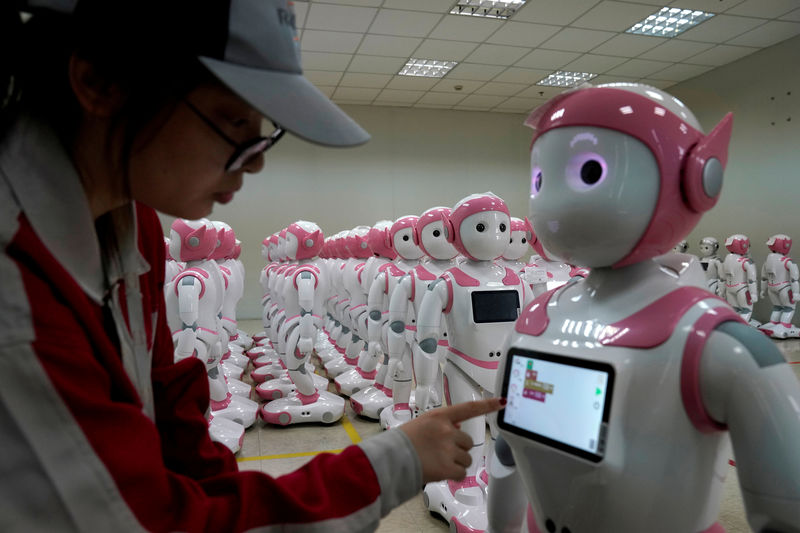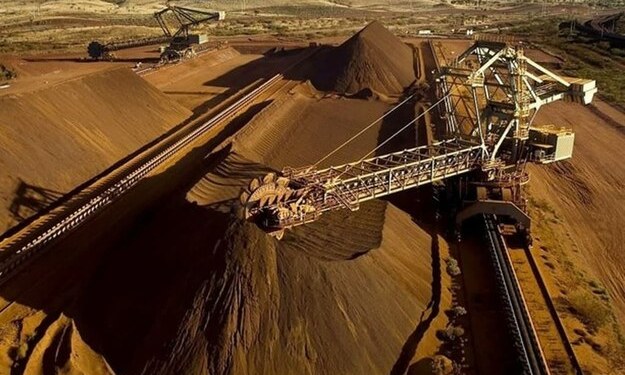 © Reuters. FILE PHOTO: A worker puts finishing touches to an iPal social robot, designed by AvatarMind, at an assembly plant in Suzhou
© Reuters. FILE PHOTO: A worker puts finishing touches to an iPal social robot, designed by AvatarMind, at an assembly plant in SuzhouBEIJING (Reuters) – China’s third quarter economic growth slowed to its weakest pace since the global financial crisis, and missed expectations, as a years-long campaign to tackle debt risks and the trade war with the United States began to bite.
The economy grew 6.5 percent in the third quarter from a year earlier, slower than the second quarter, the National Bureau of Statistics said on Friday. Analysts polled by Reuters had expected the economy to expand 6.6 percent in the July-September quarter.
The GDP reading was the weakest year-on-year quarterly growth since the first quarter of 2009 at the height of the global financial crisis.
On a quarterly basis, growth slowed down to 1.6 percent from a revised 1.7 percent in the second quarter, in line with expectations of 1.6 percent growth.
Importantly, second quarter sequential growth was revised down from the previously reported 1.8 percent, suggesting the economy carried over less momentum into the second half than many analysts had expected.
Recent economic data have pointed to weakening domestic demand with softness across factory activity to infrastructure investment and consumer spending, as a multi-year crackdown on riskier lending and debt has pushed up companies’ borrowing costs.
Economists expect China’s full-year growth to come in at 6.6 percent this year – comfortably meeting the government’s 6.5 percent target – and 6.3 percent next year.
Beijing and Washington have slapped tit-for-tat tariffs on each other in recent months and plans for bilateral trade talks to resolve the dispute have stalled, triggering a domestic equities rout and putting pressure on China’s already softening economy and weakening currency.
China’s exports unexpectedly kicked into higher gear in September, largely as firms front-loaded shipments to dodge stiffer U.S. duties. But the stronger sales drove a record trade surplus with the United States that could exacerbate the already-heated dispute between the two economic superpowers.
Separate data on Friday showed China’s factory output growth weakened to 5.8 percent in September from a year earlier, missing expectations while fixed-asset investment expanded at a slightly faster-than-expected 5.4 percent in the first nine months of the year.
The factory output reading was the weakest since February 2016.
Retail sales rose 9.2 percent in September from a year earlier.
Faced with a cooling economy, stock market wobbles and a yuan currency under pressure, policymakers are shifting their priorities to reducing risks to growth by gradually easing monetary and fiscal policy.
Last week China’s central announced the fourth reserve requirement ratio (RRR) cut this year, stepping up moves to lower financing costs amid concerns over the economic drag from the trade dispute with the United States.
Acknowledging these risks, China’s central bank governor Yi Gang said on Sunday he still sees plenty of room for adjustment in interest rates and the level of cash banks must hold as reserves.
But Yi also said the country’s economic growth would still comfortably reach its full-year target of around 6.5 pct with the possibility of overshooting.
Fusion Media or anyone involved with Fusion Media will not accept any liability for loss or damage as a result of reliance on the information including data, quotes, charts and buy/sell signals contained within this website. Please be fully informed regarding the risks and costs associated with trading the financial markets, it is one of the riskiest investment forms possible.
Source: Investing.com


























